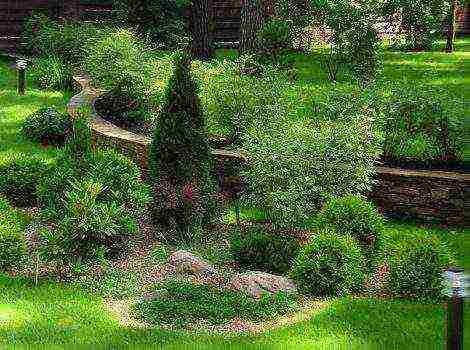Content
- 1 How to grow tobacco seedlings at home
- 2 Top dressing of tobacco seeds
- 2.1 Planting tobacco in the ground
- 2.2 Diseases and Difficulties in the Growth Process of Tobacco
- 2.3 Harvesting and drying of the tobacco crop
- 2.4 How much tobacco is enough for a smoker for a year
- 2.5 Who grows the most
- 2.6 Tobacco varieties
- 2.7 Planting seeds
- 2.8 Transplanting
- 2.9 Care
- 2.10 The soil
- 2.11 Drying
- 2.12 Fermentation
- 3 Growing tobacco - is it worth the candle
- 4 Step-by-step instructions for growing tobacco
- 5 Harvesting
- 6 Smoking tobacco varieties for cultivation
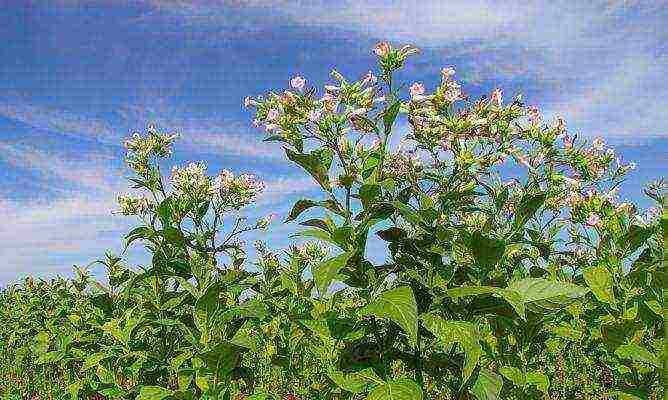 Good day, dear reader. Today, we will talk about the rules of growing tobacco at home. To find out how whimsical tobacco is and what conditions are necessary for its cultivation, a native of the Krasnodar NGO for tobacco products will help us.
Good day, dear reader. Today, we will talk about the rules of growing tobacco at home. To find out how whimsical tobacco is and what conditions are necessary for its cultivation, a native of the Krasnodar NGO for tobacco products will help us.
So, as you know, in terms of climate, tobacco is more whimsical than the well-known shag. A favorite of smokers, the product loves the sun and the mild southern climate. Makhorka, on the contrary, can grow in any climatic zone. You can see the revised and updated manual at this link. There I described my experience as simply and in more detail as possible.
As a rule, Russian lands become fertile soil for the growth of Hollyleaf 215, Trapezond, Trapezonda 15, Yubileiny. And also for shag varieties: Pekhlets, AS 18/7, local Pekhlets, local Datura.
It is known that from seven and a half to eight kilograms of tobacco fall on one would-be smoker a year.
One hundredth of a hectare of land under favorable conditions can produce up to forty kilograms of dry weight of tobacco. (Considering that the weight of a dried tobacco leaf can vary from eight tenths of a gram to one and a half grams, and up to thirty-three usable leaves can form on a tobacco plant per season).
The period from planting seedlings in the ground to the moment of harvesting is 135 days, makhorka - up to 80 days. Forcing seedlings takes up to 45 days. Usually, there are four tenths of a gram of seed per square meter of field, and about seven tenths of a meter of greenhouses or greenhouses per hundredth of a hectare. Just such an area gives up to nine hundred plants.
How to grow tobacco seedlings at home
You can grow tobacco and makhorka seedlings at home, this is usually done in flower pots or wooden boxes.
Before sowing, the seeds must be soaked in water. The soaking process takes only a day, while the temperature in the room should not drop below twenty-five degrees. The warmth in the room will catalyze the seed ripening process, which will shorten the seedling period and increase the tobacco / makhorka population.
As a rule, you need to take about three milliliters of solution per gram of seeds.
After a day, the seeds are washed, dried and laid out in several layers in a special container.
When germinating, the seeds should be covered with damp gauze or cloth from above and left either in a thermostat or in a constantly ventilated and consecrated room.
A little bit of the process of planting seedlings.
Sprouted seeds are evenly distributed over the surface of the soil, slightly pressing them into it, then moisten the soil with a spray bottle.
One square meter of the greenhouse area contains thirteen hundredths of a cubic meter of nutrient mixture, which includes two hundredths of a cubic meter: humus - 50%, earth and sand - 25% each.
The middle nutrient layer can be up to ten centimeters long. The optimal sowing periods are considered to be the third decade of February and the first decade of March.
Sowing raw materials are used in the following proportions:
- one bucket accounts for up to four grams of tobacco (makhorka - up to twenty grams).
Tobacco seeds are planted at a depth of up to five tenths of a centimeter, tobacco seeds - up to eight tenths. Before and after planting seeds, it is customary to carry out watering, where one liter of water falls on one square meter of land.
After sowing has been carried out, it is very important to ensure that the moisture level in the soil does not drop... The seed growth process is divided into specific phases:
- Phase "Cross"
This phase requires a liter of water per square meter per day; - "Ears"
There are three to five liters of water per square meter.
Also, each phase requires maintaining its own special temperature regime. For example, until the "cross" phase from sowing in the greenhouse, the temperature should be at 23-25 degrees, in the next - 20 degrees Celsius.
Top dressing of tobacco seeds
In the process of growing tobacco at home, like other plants, tobacco and makhorka require mandatory feeding. So during growing, seedlings should be sprinkled up to four times and fertilized.
As a top dressing, a mineral fertilizer solution is usually used, which is prepared in the following proportions: ten liters of water, thirty grams of ammonia nitrate, up to sixty grams of superphosphate and either twenty grams of potassium sulfate, or twenty grams of forty percent potassium salt.
Instruments:
- For feeding, experienced gardeners use a watering can with a special nozzle, the holes of which are a quarter of a centimeter in diameter. There are approximately ten liters of water per four square meters of the nursery.
Fertilizers:
- Infused chicken droppings are good organic fertilizers. To prepare it, put a kilogram of droppings in a ten-liter container of water and leave to infuse for ten days. Remember to stir occasionally. At the end of the period, the mixture will ferment and the resulting "result" can be filtered. Add water to the strained litter solution: one part of the solution is five parts of water.
A week before planting, the seedlings need to be hardened by reducing the number of water supplies, a couple of days before planting the seedlings, the water supply should be stopped altogether. Such a procedure will help you to increase the resistance of plants to unfavorable external factors, will give immunity to growing in the open air.
Well seasoned seedlings do not break even when the stem is screwed onto the finger.
Water the seedlings generously a few hours before hauling. It is usually chosen individually, thereby reducing the risk of sampling diseased or not yet fully developed plants.
Basically, plants are suitable for planting, reaching a height of fourteen to sixteen centimeters, with a stem thickness of up to three to five hundredths of a centimeter and with at least five leaves.
Planting tobacco in the ground
Planting in the ground is carried out at the most favorable temperature and the plants are planted at least ten centimeters in depth.
Tobacco planting starts on April 20th and ends on May 25th.... during strong thaws, when the risk of frost has passed completely.
The ideal planting density of tobacco is 70 by 30 centimeters, makhorka - 70 to 20. When planting seedlings along the drawn furrow, the holes are usually placed at a distance of at least thirty centimeters from each other for tobacco, and twenty for makhorka. After landing, half a liter of water is poured into the holes.
Remember: seedlings must be laid out along the furrow, turning the leaves to the left of the planter.
The planter positions the body so that he can deepen the hole with his left hand, and plant the plant with his right hand and cover its roots with earth, if you plant more than a hundred square meters, it will be much faster, I have already gotten used to it with a friend.
To help the plants adapt to the new environment and increase their growth, the roots of the seedlings can be dipped in mullein solution. It is prepared from cow dung and an appropriate amount of clay.The excess solution is shaken off from the roots, and the roots themselves are sprinkled with humus mixed with superphosphate. (1: 4)
In order for the plant to grow successfully, do not forget to regularly loosen the ground, remove weeds, water the plant and treat against parasites and diseases.
As soon as the tobacco (or makhorka) blooms, break off the top inflorescences and side shoots.
Watering the plant is done depending on the humidity. Typically, one plant has six to eight liters of water.
Diseases and Difficulties in the Growth Process of Tobacco
There are several main diseases that should be actively combated:
Peronosporosis. A solution of 0.3 percent polycarbacin or 0.4% zineb suspension is usually used against it. Five liters of such funds are sprayed on one hundredth of a hectare of land;
Aphid. When fighting aphids, experienced gardeners usually use actelik or rogor. The first of them is added 20-10 grams per ten-liter vessel, for the second 10-20 grams for the same amount of water. When aphids appear, the plants are sprayed with actelik (20-30 g per 10 l of water) or rogor (10-20 g per 10 l of water).
Harvesting and drying of the tobacco crop
The collection of tobacco leaves begins from the lower tiers of the plant, focusing on the degree of their leaves, yellowing, distributing the collection into five or six steps.
Tobacco leaves should not be removed in an unripe or overripe state, nor should they be picked when wet. The collected leaves are spread in layers thirty centimeters thick and folded in the shade. After about twelve hours, the dried leaves are attached to cords and suspended from a drying facility. Naturally, do not forget that the leaves will not dry out either in the rain or in a strong wind.
Sun drying should not last more than seventeen hours. By the way, it is after it that we get the final raw material for the product.
In cloudy weather, the raw material dries up slowly, acquiring a darkish color.
The dried tobacco must be removed carefully so that it does not crumble. Lows with tobacco leaves are folded in four and fastened to a cord in bundles of six laces. (such a set is low with tobacco will be called a havanka). Havanka, as usual. They are hung on poles in a special storage room and left until autumn. Then, in the fall, the tobacco leaves are removed, smoothed and packaged.
Fermented tobacco is suitable for making cigarettes. In addition, this very fermentation can be done at home.
Approximate fermentation algorithm:
- Fold the tobacco into a container and heat it for several days at temperatures up to fifty degrees Celsius, while the air humidity should be kept within sixty to sixty percent;
- After the expiration of the period, the humidity of the air must be increased to seventy-five percent (the temperature remains unchanged) and the raw materials must be left to infuse for five days;
- Gradually lower the air temperature over forty-eight hours and at the same time increase the air humidity to eight ten percent;
- Cooling tobacco to twenty-twenty-five degrees and reducing humidity to eleven percent. The tobacco cooling process lasts up to three days, after which the raw material is allowed to rest for a little less than a month.
Tobacco cutting is carried out with fibers, the width of which reaches five to seven tenths of a millimeter. Cigarettes are usually eighty-five millimeters long and eight millimeters in diameter. One cigarette accounts for eight tenths of a gram to one gram.
High quality cigarettes are usually made by mixing different tobacco varieties.
The sale of tobacco is not a priori problem, since due to the widespread use of cigarettes, the tobacco business is a profitable business.
How much tobacco is enough for a smoker for a year
I plant seedlings with a margin of 200-220 bushes, usually about 10% does not emerge and dies (a lot depends on what, but mainly on seeds and climatic whims), I usually plant Burleigh and Virginia 30% by 70%.I agree with the author of the video, hundreds are quite enough.
I will definitely write about the seeds, a couple of subtleties.
For a season, about 150-200 bushes of tobacco (less than 1 hundred square meters) are enough even for an inveterate smoker.
Who grows the most
Tobacco cultivation is carried out in the most unexpected corners of the world due to its high adaptability to various conditions of existence.
The appearance of tobacco depends on the environmental conditions in which it lives. Nicotiana tobacum began its commercial production in Virginia in the early 17th century.
Subsequently, it turns out that it is the climatic conditions of the southeastern United States that are ideal for growing tobacco.
Today, it is the United States that is one of the largest producers and exporters of tobacco around the world.
The first place among manufacturers of tobacco products is China, which itself consumes a significant part of its own crop. Tobacco is also actively grown in India and Brazil.
Smoking tobacco is native to America, but now it grows all over the world. There are huge tobacco plantations in China, Turkey, Brazil, India. Is tobacco grown in Russia? Yes, but only south of 55 degrees north latitude. A close relative of tobacco, makhorka, is less demanding on heat. It grows even in the Arctic.
To obtain a rich harvest, it is advisable to choose zoned varieties. Tobacco is grown in seedlings. To obtain seedlings:
- Seeds in a cloth are soaked in clean warm water.
- After a day, they are washed and, after removing excess water, they are transferred to an open porcelain or enamel dish.
- For the next 3-4 days, the swelling seeds are kept in a warm place. The fabric is constantly moisturized.
- As soon as the sprouts hatch, the seeds are dried and mixed with fine sand.
- Then they are planted in wooden boxes or flower pots with soil. The seeding depth of tobacco seeds is 7-8 mm. The soil layer in the container is 8-10 cm.
- The seeds are lightly sprinkled with a mixture of 3 parts of humus and 1 part of sand.
Water them every day, but little by little. Maintain the temperature on the windowsill or in the greenhouse within 23-25 degrees.
When the plants have two true leaves, the watering is doubled. The temperature is reduced to 20 degrees. At the stage of three to four leaves, the seedlings dive. As the stems grow, add earth. Twice the seedlings are fed with mineral fertilizers.
To prepare tobacco for a whole year, you need to plant at least 300 seedlings. For such a number of plants, you will need a plot of 40 m² and 0.25 g of seeds. Seedlings are planted from April 20 to May 25 at the age of 40–45 days. By this time, the plant stems should reach 15 cm, have 5-6 leaves. A week before transplanting into open ground, the seedlings begin to harden.
Important! Tobacco grows best in areas where sugar beets, legumes, grains and perennial grasses were previously grown.
Saplings are planted in rows at a distance of 20-30 cm from each other. The row spacing should be 70 cm.
How to grow tobacco from seedlings? During the growing season, plants are moderately watered, fed, pounded and stepson. The soil is loosened, weeds are removed. The tobacco is harvested as it ripens, in 5-6 passes.
It is necessary to dry tobacco in rooms with low humidity and high temperatures. You can also do this in the sun, after stringing the leaves on the cords. It takes 20-40 days on average to dry tobacco. To improve the taste characteristics of the herb, it must be fermented.
Now you know how to grow tobacco at home. He is unpretentious in care, needs regular moderate watering.
Read on for tips on how to melt wax at home
Growing tobacco or makhorka is not difficult at all. We are often asked about this process, and, combining personal experience with the advice of experienced ones, including our readers, we decided to publish this material. I must say that the process of growing tobacco is not much different from growing, for example, tomatoes.But still, growing tobacco, you need to know certain features of this plant. This is what our publication is about.
Content:
- General information about the tobacco plant
- Should you grow tobacco?
- Features of growing tobacco
- Tobacco pests and diseases
- Tobacco drying and fermentation
General information about the tobacco plant
Tobacco (Nicotiana) is a genus of perennial and annual plants of the Solanaceae family. Grown to obtain raw materials used in tobacco products. In culture, the following types are most often found:
- Ordinary tobacco, or Virginia Tobacco, or Real Tobacco (Nicotiana tabacum). The plant is up to 3 m high with pink flowers, a tubular corolla with sharp lobes, leaves are oblong-lanceolate, sessile. Real tobacco is quite thermophilic, therefore it is especially productively grown in hot regions. In our country, ordinary tobacco is grown south of 55 ° north latitude (this is approximately the latitude of Ryazan, Smolensk, Ulyanovsk, Ufa, Chelyabinsk, Kurgan, Omsk, Novosibirsk and Kemerovo). Ordinary tobacco is cultivated in many countries of the world and has many varieties.
- Common shag, or Rustic tobacco (Nicotiana rustica) - a plant much lower than ordinary tobacco (up to 120 cm high), yellowish flowers, corolla with a short tube and rounded blades, ovoid leaves, narrow, obtuse at the end. The leaves of this more unpretentious plant contain half as much nicotine.
In the 19th century in Russia, makhorka was cultivated on an industrial scale everywhere (even in the Urals and Siberia). Even now, some villagers traditionally grow this plant from their own seeds.
Bolivia and Peru are considered the homeland of tobacco; it was brought to Europe by the expeditions of Christopher Columbus. Traditional areas of cultural cultivation - North America, China, India, Asia Minor. On the territory of the former USSR, ordinary tobacco is cultivated in the Transcaucasus, Uzbekistan, Kazakhstan, Moldova, Ukraine, Crimea and Krasnodar Territory. Tobacco is a thermophilic plant, the optimal summer temperature for it is about 30 ° C. Moist, light, free-flowing sandy soils are suitable for it. Tobacco is propagated by seeds, growing seedlings from them, which are then planted in the ground.
All parts of the plant contain nicotine (nicotine leaves most of all - 0.75-2.88%). Nicotine is a potent neurotoxin and cardiotoxin that causes short-term euphoria. The use of tobacco in various forms and in various ways (smoking, chewing, sniffing) causes physical and psychological dependence. Nicotine is extremely toxic. Some of the substances in tobacco are carcinogenic. That's why smoking tobacco is dangerous to health.
Should you grow tobacco?
Suppose you are a smoker, and you have the good fortune to live somewhere in the south of Russia or in Ukraine. You have at your disposal several acres of land. Why not try on the role of Philip Morris or at least Jack Vosmerkin, an American?
First, some fun arithmetic. One cigarette contains about a gram of tobacco. And the cheaper the cigarettes, the less it is there. That is, the pack contains about 20 grams. If a person smokes a pack a day, he will need about 6-8 kilograms of tobacco per year.
Under favorable conditions, about 30 g of smoking tobacco can be obtained from one plant, and six to seven plants can be placed on 1 square meter. The planting density of large-leaved varieties is 70 × 30 cm, and the planting density of medium-sized tobacco and makhorka is 70 × 20 cm.It turns out that you need to grow 270-300 plants, occupying about 40 square meters. m. plot. Moreover, if the tobacco turned out to be too "evil", it can be diluted with the stems.
Therefore, from the point of view of economy and finances, it is definitely profitable for a smoker to grow tobacco.
Features of growing tobacco
Further in the article we will talk about the cultivation of ordinary tobacco.If you decide to grow shag (Nicotiana rustica), then you will not need many of the tips given, shag is much easier to grow and less thermophilic. For the middle lane, it is sown in May in the ground under a film or covering material, and it has time to grow and give a crop.
So, the first thing to attend to is the seeds and their planting. Seeds are now sold on the Internet on many sites, you just need to choose a store convenient for you and a variety of tobacco.
Tobacco varieties
There are many varieties of ordinary tobacco. It is worth saying that for the period from 1990 to 2010. in the All-Russian Research Institute of Tobacco, more than 20 new productive and disease-resistant varieties of tobacco with excellent characteristics have been bred.
As with vegetables, it is better to choose local varieties for your site. Therefore, we list some popular varieties that are zoned for the territories of the former USSR:
- Refectory Kubanets. The growing season from planting seedlings to the last breaking is 103-134 days. Technically suitable leaves on average 27 pcs. The nicotine content is 2.6%.
- Refectory 92. The variety is resistant to numerous damaging factors, viral tobacco diseases. It has a short growing season. On average, leaf breaking occurs 98 days after planting.
- Samsun 85. The variety belongs to intensively ripening varieties, mid-season - the number of days from planting to leaf breaking will be approximately 105-110 days. The number of technically ripe leaves from one tobacco bush is about 50 pcs.
- Jubilee new 142. The growing season from planting seedlings to ripening of leaves of average breaking is 78 days, to the last breaking 82 days. The nicotine content in the leaves is 2.0-2.1%. The variety has a complex resistance to tobacco diseases.
- Holly 316. Late-ripening form, intensive type of leaf maturation. Low in nicotine. From planting to maturation of the leaves of the last breaking 120 days.
Planting seeds
We recommend growing just a few bushes for the first year. So you will test your strength and find out all the nuances of the process. Therefore, you need very few seeds to get started. Tobacco seeds are as small as dust. There are about 12 thousand tobacco seeds in one gram, and about 4 thousand pieces of makhorka. To get the annual “rate” of a smoker, you need to sow only a quarter of a gram of tobacco seeds or three-quarters of a gram of tobacco seeds. You don't have to buy seeds anymore. Two or three bushes will give them more than needed for sowing a hectare.
Tobacco seeds remain viable for a long time, so sowing with old seeds is also possible, although it must be borne in mind that their germination decreases over time.
Tobacco can be planted on the seedlings on the windowsills, with or without a pick. The required age of seedlings is 40-45 days. But this technique is good only for small (up to a quarter of a hundred) volumes. However, for the first experiment we don't need more. When growing tobacco in large volumes, it is either immediately planted in the ground (in warm climates), or greenhouses and nurseries are used.
Tobacco seeds are sown superficially, scattering them over wet soil.
An important point. The seeding depth of tobacco seeds is no more than 0.7-0.8 cm (0.3-0.5 cm for shag). After sowing, they are only slightly pressed into the ground and watered very carefully so that the seeds do not go deep.
You can sow not dry seeds, but hatched seeds. In this case, 4 days before sowing, the seeds are soaked in warm clean water and placed on a damp cloth. This will speed up the germination of the seeds and shorten the time to forcing the seedlings by a week.
The optimum temperature for germination of tobacco seeds is + 25ºC… + 28ºC. If the temperature is lower, then this can delay the emergence of plants, or even destroy them altogether.
It is impossible to overmoisten, as well as overdry the seedlings. It is best to water a little, almost daily.
Transplanting
Seedlings are planted when it reaches a height of 15 cm, has 5-6 developed true leaves and a well-developed root system.At this moment, the danger of spring frosts should be avoided outside the window, and the soil at a depth of 10 cm should warm up above 10 ° C. This period is different in different regions, but approximately it is from the end of April to the end of May.
A week before planting, it is necessary to start hardening the seedlings, reducing watering and accustoming them to open air. 2-3 days before planting, watering the seedlings is completely stopped, watering abundantly only 2-3 hours before planting.
Plants are planted one at a time in the holes, after pouring 1 liter of water into them. In general, the process is very similar to planting tomato seedlings. And of course, every transplant is a shock for the plant. Therefore, it is advisable to preserve on the roots the soil in which the seedlings grew.
Care
During the growing period, it is necessary to regularly loosen the ground, remove weeds, feed and water. You can feed the plants based on the fertilization rates of tomatoes. Watering is usually limited to two to three waterings per summer, consuming 6-8 liters of water per plant. It is better to water the tobacco insufficiently than to water it.
A rooted tobacco bush can have roots up to several meters, and many tobacco growers find watering mature bushes harmful. However, it would be nice to water the tobacco a few days before harvesting.
In flowering plants, the inflorescences are broken off (verchkovation) and lateral shoots are regularly removed (pinching).
The soil
Tobacco is planted on fresh soil, in the absence of such, it is placed either after steam, or after winter crops or other plants that impose other nutrient requirements on the soil. For this reason, tobacco should not be planted, for example, after beets and potatoes.
The best soils for tobacco should be considered sandy loam, characterized by the presence of potassium and nitrogen, which are necessary for the tobacco plant.
Like all immigrants from the New World, tobacco is rapidly depleting the soil. But the remedy is known - fertilizers perfectly solve this problem.
The best fertilizer for tobacco is cow dung. Bird droppings and oilcakes are also considered useful fertilizers for tobacco. On soils poor in lime, liming is used, it has a beneficial effect not only on the culture, but also on the completeness of combustion of the tobacco plant.
Harvesting begins when the color of the tobacco leaves changes from green to yellow-green or light green. Since even one bush will have leaves of varying degrees of color, harvesting can take several weeks.
Tobacco pests and diseases
Tobacco is damaged by a number of pests, namely:
- Peach aphid, Greenhouse aphids, Tobacco aphids. Dangerous tobacco pest. A widespread species, it feeds on many cultivated and wild plants. Peach aphid inhabits all organs of the tobacco plant and sucks the juice out of them, which leads to a decrease in the yield and quality of raw materials.
- Blackleg... It is manifested by lodging and mass death of seedlings. The base of the stems becomes thinner and decays. A brown or white bloom appears on the affected surface. The pathogen remains in the soil.
- Powdery mildew. It is observed soon after planting seedlings in the ground. Separate spots with a cobweb-powdery bloom appear on the lower leaves; then the plaque becomes solid and covers the upper leaves. The mushroom hibernates on plant debris. The disease reduces photosynthesis, leads to plant oppression. Reduces the yield and quality of raw materials.
- Black root rot more often it affects seedlings, but adult plants also get sick. On the affected seedlings, the leaves wilt, turn yellow and dry out, the roots turn brown or black and often die off. In adult plants, the leaves become attached, and black and white spots form at the ends of the roots.
- Common broomstick... Distributed throughout the south and southeast of Kazakhstan. The parasite settles on the roots of tobacco and develops at the expense of the host plant, forming a powerful branching stem of purple color. As a result of mass destruction of plants by broomrape, the yield of tobacco and the quality of raw materials are reduced.Broomrape propagates by seeds that remain in the soil for many years.
- Mosaic... The leaves of diseased plants have normal green patches that alternate with light green. Later, the tissue dies off in spots. The main source of plant infection is post-harvest residues of diseased plants, both in greenhouses and in the field.
- Bacterial hazel grouse. Oily or weeping spots appear on the tips of the leaves of young seedlings or along the edges of the leaves. In wet weather, they rot, and the whole plant becomes infected from them. Round chlorotic spots appear on the leaves of grown plants, which merge, forming patches of dead tissue. The causative agent of the disease is stored in tobacco leaves, in tobacco dust, in inventory.
Tobacco drying and fermentation
Well, the most important part of getting smoking tobacco is drying and fermentation. Let's make a reservation right away: if you do not smoke, have no previous experience with tobacco, it will be quite difficult for you to determine the degree of readiness. You can either not dry it out, or rot. However, let me remind you that our grandfathers grew and dried makhorka without a higher education.
Drying
After collecting, the tobacco leaves are hung to dry in a ventilated room, while it is advisable to place containers with water there to increase the humidity. The leaves dry out in about a month.
Then the dried leaves must be moistened with clean water from a spray bottle and folded into piles, covered with polyethylene, and kept for up to a day for uniform moistening. The leaves should feel soft, but not soggy. After that, the leaves, either whole or cut, are hidden in sealed glass containers (jars) for fermentation.
Fermentation
Fermentation is a biochemical process that takes place at a constant temperature of 50 ° C for several weeks. Tobacco is fermented to reduce the strength, change the taste for the better, and reduce nicotine and tar. This can be done, for example, in electric ovens at a temperature of + 50ºC… + 60 ºC. Sometimes it is more convenient to dry cut leaves rather than whole leaves.
The resulting tobacco can be smoked in pipes, wrapped in cigarettes, fortunately, wrapping machines and tissue paper are now sold in many places. Finally, you can try making a cigar - it's easy and fun.
Of course, our material does not claim to be a detailed textbook, and many subtleties remained unaffected. And if you are serious about growing tobacco, you will need to study this issue more. But in order to get the first harvest, you already know enough.
We'd love to read your tips and secrets for growing, drying and fermenting tobacco.
And in conclusion, we remind you once again: smoking is addictive and harmful to your health. If you don't smoke, don't start. If you smoke, maybe it's time to quit? Nerd against smoking!
Once upon a time, growing tobacco was commonplace in our country. In many household plots, this plant was bred for the purpose of sale. Samosad could be found in any market.
The fact is that the cost of cigarettes at that time was too high for many. Later, when the incomes of the population began to grow, and the prices for tobacco products dropped significantly, makhorka and tobacco slowly began to disappear from the markets. This business has withered away. But even today there are a lot of lovers of such tobacco products who are happy to grow this crop at home.
Cigar or cigarette tobacco is a thermophilic culture; it can be grown outdoors only in the south of the country. In the middle lane, special greenhouses are needed for growing tobacco. But makhorka will grow anywhere except in the North, of course.
Growing tobacco - is it worth the candle
You can calculate the feasibility of growing this crop on a personal plot.
The calculation here is simple.If, on average, one cigarette contains 1 gram of tobacco (less in low-grade), then a pack contains 20 grams. An avid smoker smokes a pack a day, which is 6-8 kilograms of tobacco per year.
Under all favorable conditions, about 30 grams of tobacco can be harvested from one bush. Planting at the rate of 1 square meter for 6-7 plants, if the tobacco variety is large-leaved, the planting density will be 30 x 70 cm, while the makhorka or medium-leaved variety will require 20 x 70 cm.
From all arithmetic calculations, it follows that the culture will take about 40 square meters for an annual rate of 270-300 bushes.
It should be borne in mind that pure tobacco will be very strong, and stems are usually added to it.
If these calculations prove the feasibility of growing this crop, then it is quite possible to do such a thing.
Step-by-step instructions for growing tobacco
Here it is necessary to clarify that the cultivation of the less thermophilic makhorka (scientifically Nicotiana rustica) is much easier. This crop in the middle lane is sown directly into the ground in early May. Then the bed is covered with a film for germination so that the plants can develop normally and then get a good harvest.
The cultivation of ordinary tobacco is somewhat more complicated. To begin with, it follows from the huge variety to choose a suitable variety of tobacco for planting. When choosing, it is better to give preference to local varieties.
The growing process itself has several stages.
Germinating seeds
The way tobacco and makhorka are cultivated have a lot in common, but the difference is that the maturation of tobacco is much longer. Ripening period of shag is 75-80 days, and tobacco takes about 120 days to ripen. Therefore, it is not possible to sow tobacco seeds in the garden in the middle lane. For such a long growing season, suitable conditions are necessary. Tobacco is sown at home in pots and seedling boxes or in a greenhouse.
Algorithm of actions:
- The purchased seeds must be soaked in a solution of tartaric acid in the ratio of 3 ml per 1 gram of seeds per day a couple of days before sowing. Moreover, the temperature should be within 25-30 degrees.
- Soaking will speed up seedling ripening by a week and increase seed germination by 20%!
- After a day, the soaked seeds are removed from the solution, slightly dried, and then placed in a prepared container with a thick layer, about 3 centimeters.
- The planting material must be moistened for several days 5-6 times a day, maintaining a temperature of 27-30 degrees, which promotes germination.
Greenhouse preparation
Since growing tobacco seedlings in a greenhouse is the best option, you need to prepare them for planting.
First of all, a nutrient layer 10 centimeters thick is poured, which will make up humus, mixed with sand in a ratio of 3: 4.
In the last days of February, it is necessary to start sowing tobacco seeds. At this time, it is usually still quite cold, so the greenhouse needs to be heated.
Sowing seeds and germinating seedlings.
The prepared nutrient layer must be shed with water at the rate of 1 liter of water per square meter. Subsequently, the humidification is increased to 3-4 liters per meter.
After that, tobacco seeds are evenly scattered on the surface at the rate of 4 grams per square meter. Mahorka is sown more often, at the rate of 20 grams per meter.
The scattered tobacco seeds must be carefully pressed into the ground by 30 mm, if these are tobacco seeds, then a little deeper - about 70 mm. In conclusion, the planted seeds are watered with great care so that they do not go deep into the ground.
The required air temperature in the greenhouse at this time is about 20 degrees.
Follow-up care consists of regular plant nutrition and proper watering.
It is necessary to feed the seedlings with a solution consisting of potassium salt, superhosphate and ammonium nitrate in a proportion of 20 g, 50 g, 30 g per 10 liters of water. The soil is spilled with such fertilizer at 2 lira per square meter.
You can also use 1: 7 chicken droppings.
Immediately a week before transplanting seedlings, the frequency of watering is reduced, and the last three days are completely stopped.
It is necessary to transplant hardened seedlings with elastic stems. Immediately before transplanting, watering is done with plenty of water to make it easier to get the plants out of the soil.
After a month and a half, when the matured and grown seedlings will have several true leaves and rise to 15 cm, and its stems are about 0.5 cm thick; - it must be transplanted into open ground.
Transfer
When transplanting, they are usually guided by the temperature of the soil warming up. For tobacco, the soil should warm up to 10 degrees at a depth of 10 centimeters (depending on the climatic zone).
For transplanting plants, small pits are prepared, observing a distance of 25-30 centimeters between them, the row spacing is at least 70 centimeters.
About a liter of water is poured into the prepared holes, and then the plants are taken out one by one and planted in the prepared place. To reduce transplant stress for plants, you should try to leave more soil on the roots in which they grew. When planting in a new place, each bush should be dipped in a mixture of mullein and clay. After that, the pits are carefully covered and lightly tamped.
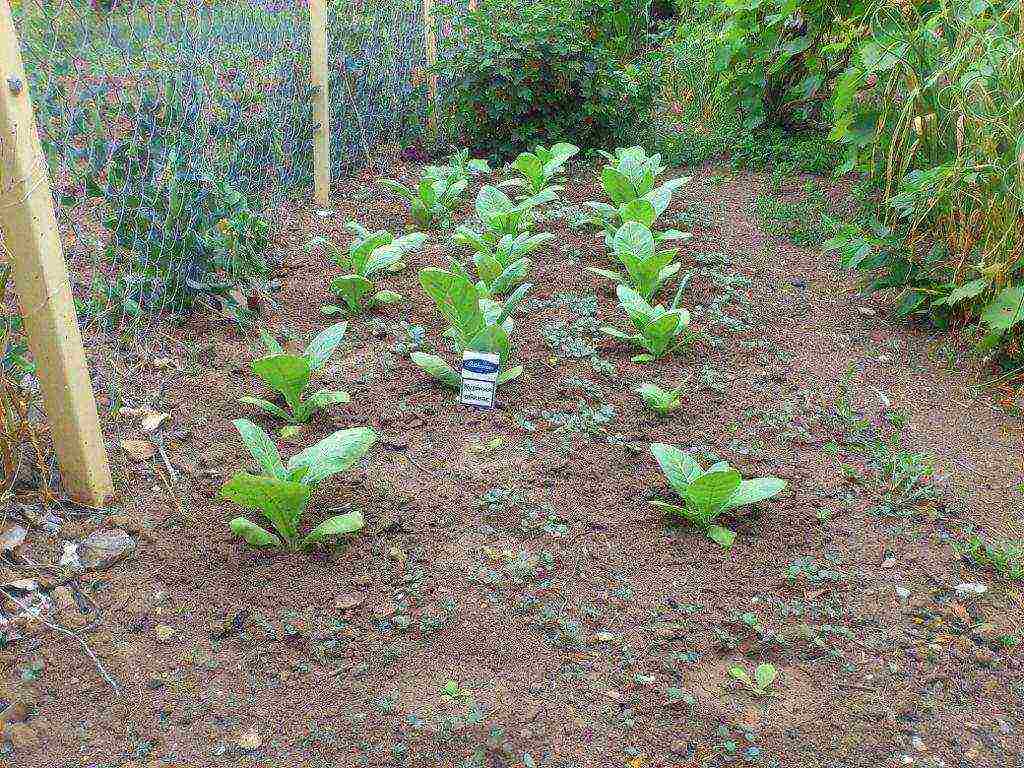
Care
Further care consists in the timely loosening and weeding of ridges, fertilization. During the growing season, tobacco bushes should be watered no more than 2-3 times, spending 8 liters of water for each bush.
In addition, it is periodically necessary to carry out pinching of plants and break off the inflorescences in a timely manner.
Diseases and pests
This plant has two main growing problems. The first is aphids. The most effective way to combat this scourge is Rogor-S. The second problem is peronosporosis. To get rid of such a problem, a 4% suspension of zineba is used, which must be applied at the rate of 5 liters per 10 acres. It is also possible to use a 0.3% polycarbocin solution.
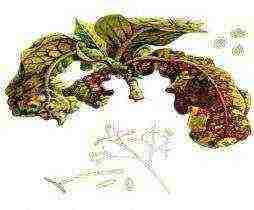
Growing tobacco at home, video:
Harvesting
In general, growing tobacco is not difficult. It will be more difficult to process the harvested crop.
There are some subtleties here. When the tobacco leaves begin to turn yellow, then you need to start harvesting. But it is imperative to remove the tobacco sheets, starting from the lowest rows.
It is especially important to ensure that the leaves of smoking tobacco are whole and dry!
After collecting the leaves, you need to transfer them to a shaded place for 12 hours, putting them in a pile in a layer of 30 centimeters so that they wither. After that, the leaves are strung on cords and hung to dry. It is necessary to find a place protected from the wind for this purpose. In suitable sunny weather, it will take about two weeks to dry.
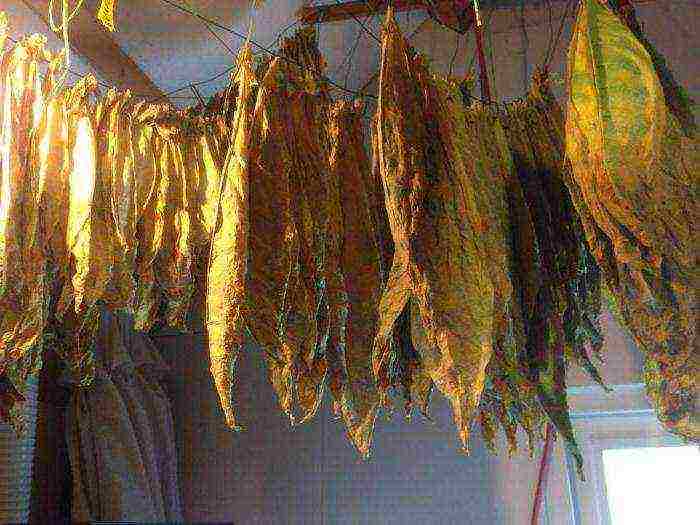
After that, you need to take 5-6 pieces of cords on which tobacco leaves are strung, fold them 4 times, and then hang them on a special hook. This design is called havanka.
The harbors are transferred and dried in a well-ventilated area until completely dry, by hanging them on the crossbars.

With the arrival of cold autumn days, dry tobacco leaves are removed, and then folded into piles, carefully smoothing.
The process is complete and the tobacco can be consumed.
Smoking tobacco varieties for cultivation
There are several of the more well-known varieties of tobacco that are easy to grow at home.
"Trapezond" is a variety resistant to various diseases with a short growing season (only 100 days)
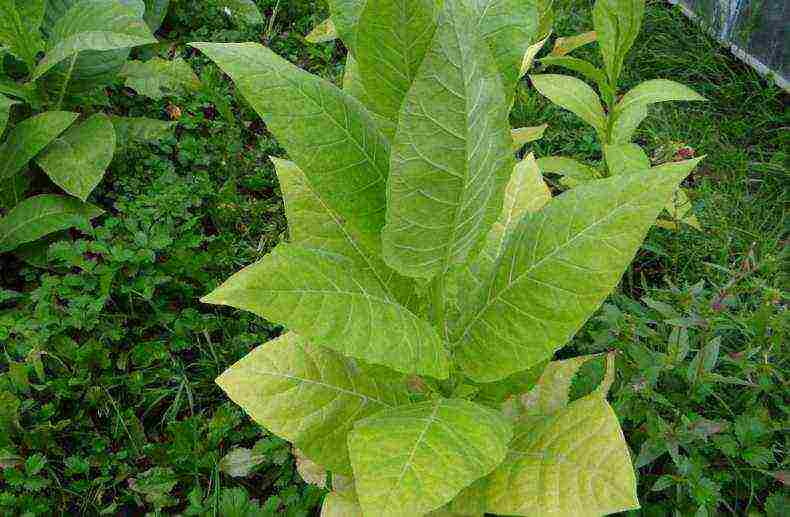
Variety "Virginia" - early maturing, with a good smell, strong tobacco. This variety is quite resistant to various diseases and various whims of nature.
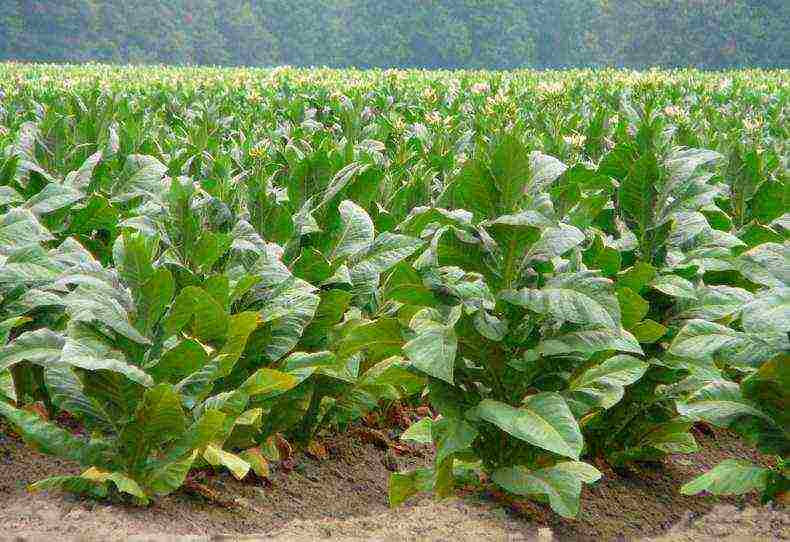
Variety "Yubileiny" - early ripening, after 80 days you can harvest. It is quite resistant to disease.
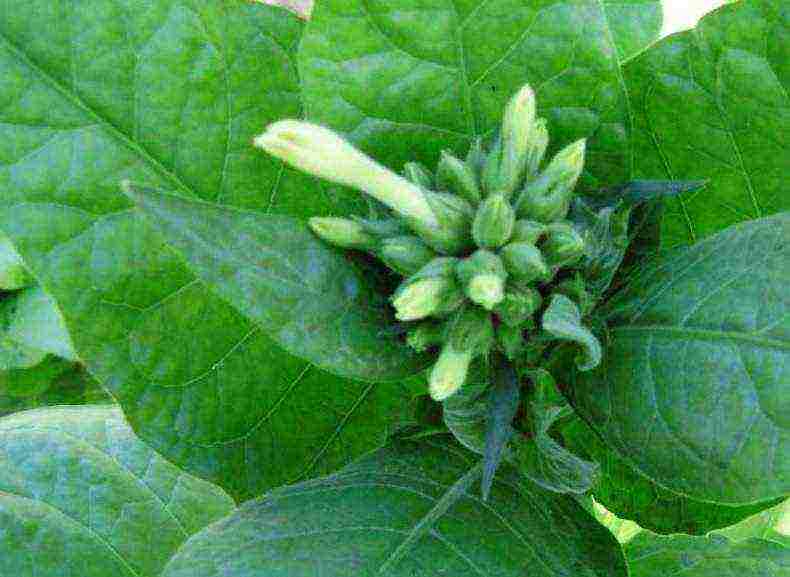
Samsun variety - ripening takes 110 days. This is one of the high-yielding varieties; up to 50 tobacco leaves grow on one bush.
"Village tobacco" - frost-resistant.It can be grown both outdoors and on a loggia or window.

If you correctly decide on the variety of smoking tobacco, then it is quite possible to grow this crop on a personal plot. You just need to use the knowledge gained.

